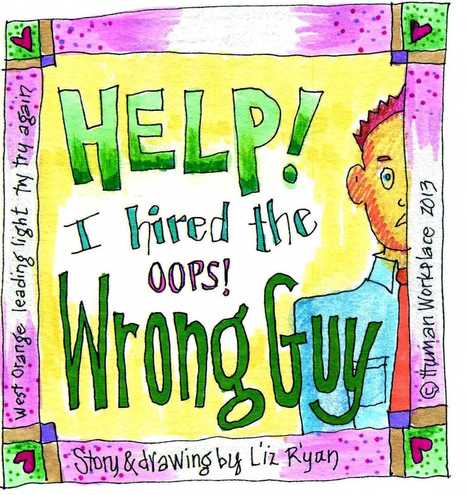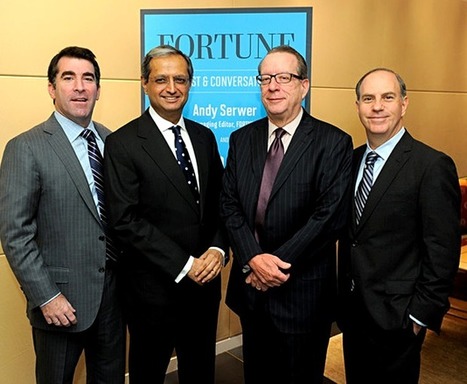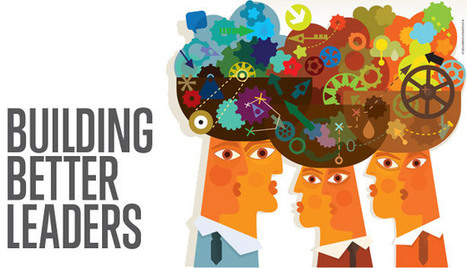 Your new post is loading...
 Your new post is loading...

|
Scooped by
Linda Holroyd
September 16, 2013 4:40 PM
|
FountainBlue’s September 13 When She Speaks, Women in Leadership Series event was on the topic of Women Making Their Own Rules. Below are notes from the conversation. We were fortunate to be in the midst of brilliance – witnessing and absorbing the enriching, inspiring words of our incomparable panelists, and laughing, nodding and exclaiming as we strive to integrate their wisdom into our day-to-day activities. Our panelists represented women of backgrounds from humble to privileged, from engineering to legal and marketing, yet they all had much in common: They rose to a level of impact and prestige that directly and indirectly impacts the success of their organizations, their teams and their networks.They started by first knowing themselves, and brought that self-awareness to bear in strategizing career and life decisions.They proved themselves in ways large and small, quantatively and qualitatively, and influenced the success of all they touched in ways unimaginable, sometimes even by themselves.They generously shared their strategies, wisdom, tools, and time with promising others.They succeeded by building relationships and understanding the motivations of those they touch.They constantly strive to improve themselves, leveraging the people and resources around them while also benefiting same.They ARE that beam of light that makes you want to be a better you, and gives all a brighter hope for the future, seeing the best in ourselves, those around us, and the possibilities for all of us. Below are their top ten kernels of wisdom shared by our panel about women who make their own rules. Know Yourself 1. Know yourself, your values, and your needs. These are your non-negotiables, so make a stand behind them.
2. Everyone has their own story, their own challenges. Leverage yours to get to where you’d like to go.
3. Know why you’re making your own rule, as it would necessarily mean that you’re breaking an existing rule. Who is making the existing rule? How would your own rule better benefit all stakeholders? What’s the strategy to get the right people to buy into the new rule? How do you best execute, follow-through, correct, etc? Prove Yourself 4. If you focus on yourself and your own needs first, you will then be in a better position to help others get there too. So, first prove yourself before you aspire to make your own rules. People won’t follow you and let you make your own rules unless they can believe in you, and in the way you would follow through and execute.
5. Mistakes happen – focusing on the learnings will help narrow in on what will work in the short term and the long term. Perseverance and grit and having a tough skin will help you rise above your mistakes and increase the likelihood that you will be able to forge change with your new rule, particularly lasting change. So follow through and make something happen, despite the challenges, the errors, and especially when it’s difficult to do so.
6. Communicate your best practices and your results so that others beyond you and those immediately around you can also benefit. Speak the language of the audience to which you’re communicating – ride that balance between appearing over-confident and arrogant and appearing Stretch Yourself 7. Embrace the uncomfortable as the best learnings lie there. A good way to embrace the uncomfortable is to welcome and encourage others who-don’t-think-and-act-like-you-do to also make their own rules, provided that it’s also for the greater good.
8. When people see the promise in you, understand why they are giving you that next challenge, determine if it’s the right strategic next-step for you, and create your own rules to get from here to there, on your own terms, in your own way, especially if it makes you uncomfortable to even think about doing so! Stand and Deliver 9. Humor is a brilliant way to share wisdom and learnings and create bonds between people. Make It Bigger Than You Are 10. Think well beyond money, title, position, power, and more about making a difference, making your mark on the world on your terms. Doing things for the greater good and communicating why it benefits others and how they can participate will engage the right stakeholders to help change rules, for the betterment of all! In the end, remember that it’s not a destination, it’s a journey, so strive to make it one full of happiness and learnings. Use our illustrious examples of how you too can share your successes and challenges and help you gain the strength, fortitude, resources and perspective to achieve results benefitting others.

|
Scooped by
Linda Holroyd
September 3, 2013 12:29 PM
|
Peter Fuda introduces in Leadership Transformed, seven interdependent metaphors to explain and accelerate leadership transformation in leaders at any level.
The seven metaphors help you to get a grasp on the concepts and issues involved in leadership development. Leadership development doesn’t happen in parts. These interdependent metaphors emphasize the holistic nature of leadership development. They are:
1. FIRE: The motivational forces that initiate and sustain transformation efforts; including a burning platform and burning ambition, as well as personal and organizational reasons for change. Fire is at the center of the seven metaphors because if the why isn’t there, the other factors are just going through the motion. Fuda emphasizes burning ambition—fire from within—as the only motivation that sustains. You may change out of fear—burning platform—and it may provide the initial spark, but it burns briefly.
2. SNOWBALL: A virtuous snowball of accountability that propels the change effort forward; starting with the leader, and building momentum as others are "swept up" in the journey.
Building momentum is contingent upon getting a critical mass of leaders on the journey—perhaps even replacing those who are not committed to growth. Uncommitted leaders only cause drag on the snowball by not living the agreed standards of behavior.
3. MASTER CHEF: Artful application of the "leadership science" (frameworks, tools and strategies), which enable a leader to advance from amateur cook to "master" chef.
Pioneering French chef Marcel Boulestin once said “cooking is not chemistry, it’s an art. It requires instinct and taste rather than exact measurements”. Similarly, transformation is accelerated when leaders work fluidly within a recipe (change frameworks), and artfully deploy their utensils (tools) and cooking methods (strategies). Leaders should become less rigid and more intuitive over time. This requires that a leader develop critical thinking skills and a deep understanding of where they are going and what leadership is. Otherwise they become tied to formulas and rote practices.
4. COACH: A team of consultant(s), colleagues and supporters that collectively coach a leader toward their aspirations.
It’s not about coaching. It’s about being coached from a variety of sources—consultants, colleagues, and family members. We can learn from anyone. Coaching is most powerful when all groups identify mutually beneficial outcomes from the leader’s transformation, and create a trusting environment for that coaching to take place. Hunter S. Thompson said, “He who is taught only by himself has a fool for a master.”
5. MASK: This metaphor has two aspects: the concealment of perceived imperfections, and the adoption of an identity that is misaligned with a leader’s authentic self, values or aspirations.
The mask is a heavy burden to carry. It creates inner conflict with a leader’s deeply held values and aspirations, and can negatively impact on important relationships. When leaders drop their mask in favor of being their "authentic self," the power this unleashes is atomic in scale; they get more done, build more trust, have far more enriching interactions and feel more fulfilled.
6. MOVIE: Processes for increasing self-awareness and reflection, which allow a leader to "edit" their performance, and direct a "movie" in line with their leadership vision.
Often leaders find themselves acting in a repetitive movie—their own version ofGroundhog Day, doing the same thing day after day with the same result. By stepping out of the movie and viewing the footage objectively in the editing suite, leaders can hone their reflective capacity, and eventually, learn how to slow down their movie. From this place of stillness, leaders can begin to direct their own movie and choose a better response—in real time. A good metaphor for understanding purposeful leadership.
7. RUSSIAN DOLLS: A complimentary set of journeys that interact with a leader’s personal journey of transformation.
A leader’s personal journey never exists in isolation; it is surrounded by multiple other journeys occurring concurrently. When the journeys are aligned, something magical can happen. Conversely, whenever one doll tries to pull in a different direction, its proximity to the other dolls ensures that it doesn’t get very far.

|
Scooped by
Linda Holroyd
August 28, 2013 1:41 PM
|
Here are some tactics that I devised to shake off discouragement: I employ a three-times rule, trying new approaches to an idea at least that many times. (There is one effort I’m still pushing after six years – patience and timing are critical! Or else I’m just crazy.) Three times may not be a charm, but it helps. Each engagement is a chance to hone the idea. Rejection is a chance to get feedback.Good storytelling is essential, so I developed a mantra: You can’t sell it if you can’t tell it. Bring the vision to life; make the benefits relevant, the impact believable.Align yourself with others to bolster your success rate. When you have teammates, ideas get better, you can leverage their credibility and have more people pushing for an idea.Spend time with your biggest critics. Often they make valid points that can make the plan better. And by incorporating their input, you may find new allies whose support will speak to your ability to win people over.Passion is rocket fuel. It makes up for a lot of gaps and buys you time. If you don’t have passion, then pass – good ideas abound, but they need optimistic, energetic champions to succeed. Not every idea gets a green flag. Even good ideas face constraints around timing, funding, resources and focus. Sometimes you just work with people who don’t want change. You move on (a topic for another time). But if there’s a glimmer of hope, then keep going.

|
Scooped by
Linda Holroyd
August 20, 2013 5:17 PM
|
What’s The Secret? The only goal for a meeting is “to decide and commit.” No other objective is worth meeting for. No meetings to “discuss.”
No meetings to “update.”
No meetings to “review.”
No meetings to “inform.”
No meetings to “report.”
No meetings to “present.”
No meetings to “check.”
No meetings to “dialogue.”
No meetings to “evaluate.”
No meetings to “connect.”
No meetings to “think.”
No meetings to “consider.”
No meetings to “educate.”
No meetings to anything but “decide and commit.”

|
Scooped by
Linda Holroyd
August 19, 2013 1:46 PM
|
I'm glad you see that Fred's hire was your mistake and not his. One of the worst situations I run across is the one where a hiring manager brings a new person on board, isn't satisfied, and makes it the new hire's fault! Our goal is to move Fred along his path respectfully and with dignity, clearing the way for you to get the right person into your Partnerships Manager spot and your anxiety level down to half what it is now. Here's what you'll do: 1) Talk to the HR manager at headquarters before you proceed, to keep him or her abreast of your plans. (Don't let your HR person, if he or she comes from the Godzilla Old School branch of HR, suck you into some horrible Progressive Discipline vortex. That crusty Progressive Discipline garbage is insulting to adults. We don't put forty-seven-year-olds on probation, for God's sake. We say to them, "This doesn't feel like it's working, to me. What do you think?") It's an energetic mismatch between you and Fred. He didn't do anything wrong, and he isn't at fault or remiss. No one is. It's just not a good partnership, as it were. 2) Sit down with Fred and talk with him about your concerns. Let him know that it isn't going to work out between him and this job. You aren't interested in writing some stupid 90-day action plan. Your gut is speaking loudly now, the way it does when you ignore its quieter nudges. Fred has to move on. But you hired him, so you owe him. Six weeks pay is reasonable for three months of work, but the issue for Fred is going to be "What am I going to tell prospective employers about this incident?" Ethically, you have to help cover him on that front. 3) Offer Fred a very limited and defined short-term consulting gig that will let him keep his association with your company (for instance, on his LinkedIn profile) while he's job-hunting. The last thing we want Fred to have to say is "It didn't work out for me at XYZ Industries, so they let me go" and poor guileless Fred is likely to say just that if you don't coach him differently. He should say instead "I went over to XYZ Industries to help them get their Partnership infrastructure together, and it turned out that they needed a guy to go out and find deals, whereas I'm more of the back-end administrator guy, so I'm consulting for them now." That covers Fred's exit and also helps steer him into jobs that will be a better fit for him than yours is. It's going to cost you six weeks of Fred's salary (three months would be even more decent of you, if you can swing it) plus a little cash for his short-term consulting project (at Human Workplace we call that type of project an Exit Ramp). Here's what you'll win for that small expense: Your reputation as a decent company and an ethical leader will stay intact.Your staff will see that you don't throw people under the bus when things aren't working out the way you want them to.Fred will continue to say good things about your company, and perhaps turn you on to great partnerships in the future.You'll be able to look in the mirror in the morning without wincing.

|
Scooped by
Linda Holroyd
August 16, 2013 5:46 PM
|
9 Tips to Avoid Getting Sidetracked Too often we think we know exactly what is going on in our minds and what is affecting our behavior. Even though we are committed to our plans we find that the end result bears little resemblance to our best intentions. Somehow we get sidetracked.
We face internal pressures, relational pressures, and external pressures to take us off course. These pressures keep us from being consistent with our self-image as capable, competent, and honest individuals.
In Sidetracked, Francesca Gino has highlighted nine reasons we get sidetracked—why our decisions get derailed—and provides solutions to avoid them. Here are nine tips to avoid getting sidetracked:
Raise your awareness of the subtle influences on your decisions. For instance, our biased views of how competent and capable we are can make us unwilling to listen to the opinions of others. We tend to value expensive advice over inexpensive advice.
Take your emotional temperature before you make a decision to see if an unrelated event is affecting the decision at hand. Our moods affect our decisions. Ask, "Is this emotion clouding my judgment?" The emotions we experience while implementing our plans can sidetrack us.
Zoom out to include more information when making our decisions. Ask: "Why did I choose the information that I did?" "What information am I missing?" "What was my initial plan?" and "Why did I embark on this course of action?"
Take the other party's point of view. We tend to overestimate the extent to which others share our attitudes and feelings, to believe that other have more access to our internal states than they actually do, to use ourselves as a standard when evaluating others, and to draw on our own experiences when anticipating how others will evaluate us. What seems obvious to us is not always obvious to others.
Question your bonds—your links and similarities—to those around you and consider whether these bonds may be influencing your decisions for the worse. The behavior and decisions of others not only affect the decisions we make but the conclusions we reach about other people. “We don’t have a stable moral compass.… What I’ve found in my research is that it’s easier to pick up the unhealthy habits of others than to be swayed by their good behaviors.”
Check your reference points to consider the motives—social comparisons and emotions—behind your decisions. "The way we define and understand ourselves is an inherently social process….Our decisions are biased by the comparisons we strategically choose in order to alter how we see ourselves." By becoming more attentive to frames, we can become less influenced by them.
Consider the source to determine if your judgment is warranted based on all the information available to you. Are you evaluating the right information? "We tend to "rely on irrelevant, but seemingly important, information when making judgments."
Investigate and question the frame to see its impact on our behavior or decision. A change in framing can cause us to accept or abandon our carefully thought out goals and plans. How we frame things dramatically affects our acceptance and commitment. In an interesting study the author and others conducted, they found that framing the orientation and training process in a way that encourages self-expression of personal identities and signature strengths produces beneficial effects for the employees and the organization—namely motivation and retention.
Make your standards shine by putting them first and discussing them more often. Too often we just need the right opportunity to come up with a reason to reinterpret our behavior.

|
Scooped by
Linda Holroyd
August 14, 2013 6:19 PM
|
Last week, CEO.com published its 2nd annual Social CEO Report, examining in great detail the social networking presence of each of the Fortune 500 CEOs. Their findings were surprising: Most notably, 68% of CEOs have absolutely no presence on any of the major social networks (Twitter, Facebook, LinkedIn or Google Plus). Here are a few more highlights from the report (or lowlights, depending upon how you look at it): 1) About one quarter, or 28% (140) of the Fortune 500 CEOs are here on LinkedIn, the leading social network for business professionals. They include fellow LinkedIn InfluencersMeg Whitman, Jamie Dimon, Jeff Immelt and John Donahoe. 2) Just 7% (35) of the Fortune 500 CEOs are on Facebook, led obviously by Facebook CEO Mark Zuckerberg, with 16 million followers. 3) A paltry 5.6% (28) of the Fortune 500 CEOs are on Twitter, and just 3.7% (19) of them have active Twitter accounts. So why aren’t more Fortune 500 CEOs embracing social media? The four reasons the report cites are: 1) Not enough time 2) Uncomfortable with transparency 3) Greater risk 4) Resistance to change I don't know the Fortune 500 CEOs who aren't using social networks personally, so I can only speculate about why they're not going social. I'd boil it down to two primary reasons myself:fear and lack of perceived value. We fear what we don't yet know and understand, and Fortune 500 CEOs are amongst the last demographic on the planet to know and understand social networks. We don't make time for what we don't see value in - and surely these CEOs don't see value in spending time on social networks. They think they have better things to do. I don't think they do. As I've written before, the bigger value to social media for business isn't in the talking, it's in the listening. CEOs can use social media to listen to their customers, competitors, competitors' customers, and employees. They can discover new products, new markets, and new opportunities. Once they start talking, they can tell their story - provide thought leadership, and attract new partners, vendors, talent and customers. They can be the spokesperson for their companies online the same way they are the spokesperson offline. Said Josh James, CEO of Domo, the company who sponsored the report: “CEOs who use social media are growing their businesses, attracting lifelong customers, generating exposure for their companies and closing new deals. As consumers become more social savvy, so must company leaders." I say to CEOs: Your employees are on social networks. Your customers are on social networks. Your shareholders are on social networks. Your nimble, startup competitors are on social networks. If you're not on on these social networks, you not only risk looking like you're out of touch, you risk actually becoming out of touch. Here's the thing: Fortune 500 CEOs are still afraid of going social - but perhaps they should be more afraid of their nimble competitors going social and quickly catching up, taking their jobs - and their spots on the Fortune 500. I'm a CEO of one company and a Chairman of another - and I've found enormous value in using social media personally and professionally. But I'm running social media companies, so there's an obvious, unfair bias. So, CEOs of Fortune 500 companies and all companies around the globe, don't take the advice to "Go social" from me. Take it from Warren Buffet, Rupert Murdoch, Marissa Mayer,Ralph Lauren and Meg Whitman, who'd all likely say: Go social or go home.

|
Scooped by
Linda Holroyd
August 14, 2013 1:33 PM
|
Organize for journeys. Many journeys involve a complex series of internal hand-offs (e.g. customer service needs to send the installation time to the installer in the field). Unfortunately, most organizations function in silos around each touchpoint and don’t have people responsible for the journey overall. That requires pulling together teams of people across functions to understand their roles in the context of the journey overall, and developing new ways of managing the journey. You’re going to need to get creative. One telecom company redeployed senior executives to become “chain managers” with responsibility for overseeing specific journeys. It also created war rooms where the chain managers could monitor journeys and meet with the functional teams involved.
Create incentives for journeys. This point is obviously related to organizing for journeys above, but it’s so important I wanted to highlight it specifically. If sales reps are rewarded for closing sales or customer service representatives for keeping calls short, then that’s what they’ll do. You’ll need to create incentives tailored to specific journeys you’ve identified as important. Back-office employees, for example, should be rewarded for the accuracy of order tickets rather than just the number of them. Customer service personnel should have incentives for identifying root cause issues when customers call. All those involved in a given journey should be rewarded for the completion of a successful journey.
Measure journeys. It’s a truism that you manage what you measure – are you measuring the right things? If it’s just “call duration” or “number of sales generated online”, you’re focusing just on success at the touchpoint level. Dashboards and metrics need to measure the entire journey with an emphasis on those journeys that matter the most (to the customer and the business) and identifying. This isn’t just a continual process; it’s continuous, e.g. you need to monitor journeys constantly, make adjustments, and build feedback loops from the frontlines so that your metrics drive on a daily even hourly basis decisions.

|
Scooped by
Linda Holroyd
August 14, 2013 1:29 PM
|
It’s maddening when people do the opposite of what we tell them to do. Remind your boss to look at a report, and he puts it off longer. Discourage a friend from taking a job, and she accepts it. Nudge a colleague to drink less, and she pours herself another drink. Tell a child not to touch a hot stove, and he immediately reaches for it. And you’re reading this post, even though the headline demanded the exact opposite. What were you thinking? The psychology of reverse psychology boils down to three key principles. If you’re not careful, all three can become sources of bias or weapons of influence. 1. Reactance: forbidden fruit tastes so much sweeter When someone discourages you from doing something, you often feel that your freedom is being threatened, which motivates you to regain choice and control by doing exactly the opposite. Experiments show that children become more interested in a toy after they’re put under severe rather than mild pressure not to play with it, and children and adults become more likely to taste fatty foods when labels explicitly warn against them. One classic study even found support for the Romeo & Juliet effect: the more parents interfered with a romantic relationship, the stronger the feelings of love the couples developed over the next year. As Mark Twain once wrote, “Adam was but human… He did not want the apple for the apple’s sake, he wanted it only because it was forbidden.” 2. Rebound: whatever you do, don’t think about a white bear When someone tells you not to think about something, your mind has a sneaky way of returning to that very thought. In a brilliant study led by psychologist Daniel Wegner, people were told not to think about a white bear. They spent the next 5 minutes thinking aloud, saying everything that came to mind, and ringing a bell if they spoke or thought of a white bear. They couldn’t escape the white bear: on average, it appeared in their thoughts every minute, and most people accidentally uttered “white bear” out loud once or twice. When the 5-minute suppression period was over, things got even worse: they thought about it more than twice as often as people who had been directly instructed to think about a white bear. When we try to suppress a thought, two things happen. The productive effect is that we consciously search for thoughts that don’t involve white bears. The counterproductive effect is that we unconsciously monitor for failures. In the back of our minds, we’re keeping an eye out for pale furry creatures in case they prove to be of the polar variety. 3. Curiosity: I wonder what’s inside… When a behavior is forbidden or discouraged, it’s hard not to become intrigued. As Chip and Dan Heath write in Made to Stick, “it’s like having an itch we need to scratch.” Experiments reveal, for example, that people are more likely to watch violent TV shows, and play violent video games when labels warn against them. And there are many examples of books becoming more popular after they’re banned. There’s a mystery to be unraveled: what could be so bad about this? When you started surfing the internet today, chances are that you carried an implicit expectation that a writer would be encouraging you to read his writing. If so, my headline surprised you by violating that expectation. “Why in the world would an author tell me not to read something he wrote? That doesn’t make any sense. Is he out of his mind?” These principles of reverse psychology can be used against us. In one study, psychologists asked 159 people if they had ever deliberately tried to get people to do something by recommending the opposite. More than two thirds generated a convincing example, and reported using reverse psychology an average of 1-2 times a month, with relatively little difficulty and high effectiveness. One respondent admitted, “One time I said that my friend had a good haircut when she didn’t. Usually, she disagrees with my opinion so she changed it. Which was good.” Is this ethical? Some might say that in the case of a haircut, the (split) ends justify the means. When people are resistant to us or our ideas, and we have their best interests at heart, it’s acceptable to mislead them for their own good. Others would argue that a meaningful relationship allows, or even requires, transparency. If we can’t be honest with someone about our intentions, how much of a bond do we really have? Wherever you stand on this spectrum, my hope is that you’ll be more attuned to reverse psychology when it wanders into your interactions. I also you’ll prevent it from biasing your choices. Next time you find yourself opposing a recommendation or warning, it’s worth asking whether it’s genuinely a bad idea. Maybe you’re just trying to fight for your freedom or scratch an itch.

|
Scooped by
Linda Holroyd
August 5, 2013 6:17 PM
|
While many people don't like to sell, most find themselves having to persuade someone at some point. Persuasion is not just for salespeople and their prospects. You may try to persuade an employee to perform better, or perhaps you want to persuade your boss to take on your brilliant idea. Often the most effective persuaders are your kids. Somehow they come by it naturally while you, the adult, has to work hard to find the persuasive path to success. Whatever your persuasive need, here are 7 things that the most persuasive people consistently do: 1. They Are Purposeful Truly persuasive people understand their power and use it sparingly and knowingly. They understand that most conversations do not require trying to get someone to do or accept something. Aggressive pushers are a turn-off and will put most people on the defensive. It's the person who rarely asks or argues that ultimately gets consideration when they strongly advocate an idea, especially when they do it with power and persistence. Simply put, they pick their battles. Want to persuade more? Argue and advocate less often. 2. They Listen ... and Listen ... Then Listen Some More People who know how to persuade also know that just pushing your own argument will get you nowhere. They certainly are able to articulate their position in a convincing way, but that is only half the equation. They are actively listening when in persuasion mode. First, they are listening to assess how receptive you are to their point of view. Second, they are listening for your specific objections, which they know they'll have to resolve. Last, they are listening for moments of agreement so they can capitalize on consensus. Amazingly persuasive people are constantly listening to you and not themselves. They already know what they are saying. You can't persuade effectively if you don't know the other side of the argument. 3. They Create a Connection It's easy to dismiss people who are trying to persuade you if you have no emotional stake in them or their argument. Really persuasive people know this, so they will be likeableand look for common ground to help establish emotional bonds and shared objectives.They show empathy for your position and make it known that they are on your side. They manage their impatience and wait for you to give them permission to advocate their approach. You'll persuade people much more easily if they are open and aligned with your desires. 4. They Acknowledge Credibility Really persuasive people understand that there is no sense wasting time arguing facts. Most of the world does not function in black and white. They value strong opinions and will make sure that you are entitled to yours. In fact, they will make sure they give you full credit for every argument of yours that has some validity. This makes it harder for you to fully dismiss their point of view. When you are persuading people, reinforce their credibility on facts and opinions rather than dismissing them outright. Then they'll be more likely to pay you equal respect in the exchange and be more open to the merits of your opposing view. 5. They Offer Satisfaction Smart persuaders know that they don't have to win every little battle to win the war. They are more than willing to sacrifice when it helps the overall cause. They are ready to find the easiest path to yes. Often that is simply to give you what you want whenever possible. In my old lending days, we would often deal with busy underwriters who asked for items we knew they already had. Instead of arguing the point, we would just resend the documents and save our energy for issues that were not so easily resolved. Give ground where you can and hold your ground only where it matters. Choose being successful over being right. 6. They Know When to Shut Up Successful persuaders get that you don't win the battle by constantly berating people with an unending verbal barrage. Wearing people down is not an effective strategy. They carefully support their arguments and check in with questions that will help to close the conversation. Then they step back. The great sales trainer Tom Hopkins still today teaches these decades-old techniques of his mentor J. Douglas Edwards. His most important lesson is "Whenever you ask a closing question, shut up. The first person who speaks, loses." 7. They Know When to Back Away Urgency and immediacy are often the enemies of real persuasion. It's possible to close a less significant sale through urgency, but deep ideas require time and thought to take root. Great persuaders bring you along in your own time. And they give you the space and time to carefully consider their position. They know that nothing is more powerful than your persuading yourself on their behalf. That almost never occurs in the presence of the persuader. The next time you want to persuade someone of something truly important, follow the tips above, make your case, and walk away. If they don't come around, you were probably wasting your effort in the first place.

|
Scooped by
Linda Holroyd
July 25, 2013 11:33 AM
|
Truly loyal employees are not just committed to helping their companies succeed; their loyalty is also displayed in other ways, some of them surprising. 1. They display loyalty through integrity. Many people assume loyalty is proven through obedience: Often unthinking and unquestioning, even when a request or directive falls into a gray area or, worse, is unethical or illegal. An employee who consistently seeks to do the right thing is not just following a personal credo – she’s also looking out for your long-term interests. You may see her as disloyal today… but in time you’ll realize that she displayed the highest form of loyalty by helping you avoid missing the “do the right thing” forest for the “do it right now” trees. 2. They generate discussions others will not. Many employees hesitate to voice their opinions or feelings in a group setting. Some even hesitate to voice their opinions in private. An employee once asked me a question about a new initiative. After the meeting I pulled him aside and said, “Why did you ask about our new pricing strategy? You know what we’re doing – you were part of the planning.” He said, “I do, but a lot of other people don't, and they’re hesitant to ask since they aren’t directly affected. I thought it would help if they could hear what you’re thinking and what we’re planning.” Loyal employees have a great feel for the issues and concerns of the people around them, and they ask the questions or raise the important issues when others won’t. They know, for the company to succeed, that you need to know what employees are thinking… and that employees need to know what you are thinking. 3. They praise their peers. Truly loyal employees care: About the company, about its customers, about its mission… they feel they’re working for something greater than just themselves. So they appreciate when another employee does something great because that means the company is fulfilling its mission. Employees that praise and recognize others, especially when it’s not their job to do so, don’t just display great interpersonal skills. (When you do something well, praise from your boss feels great… but it’s also, at least generally speaking, expected. At least it should be. Praise from a peer feels awesome, especially when you respect that person.) By praising others, they show they care. Caring forms the basis of loyalty. 4. They dissent and disagree Every great company fosters debate and disagreement. Every great leader wants employees to question, to deliberate, and to push back. Weighing the positives and negatives of a decision, sharing conflicting opinions, playing devil's advocate… disagreement is healthy. It’s stimulating. It leads to better decisions. Loyal employees share their opinions, even when they know you may not initially appreciate those opinions, because they want the company to be better tomorrow than it is today. And they’ll occasionally take stands against a point of view or decision. 5. They support in public. After a decision is made, loyal employees get behind that decision even if they privately disagree. And they don’t just pay the decision lip service; they support the decision as if it were their own – because when you’re loyal, every decision is, ultimately, your own. When they disagree, some employees (the not so loyal ones), whether passively or actively, try to show that a decision they disagreed with was in fact wrong. A truly loyal employee puts aside his feelings and actively tries to make every decision the right decision – instead of willing it to fail so they can prove themselves right. 6. They tell you what you least want to hear. The Inverse Rule of Candor states that the greater the difference in “rank,” the less likely an employee will be to openly take a different position: An entry-level employee is fairly likely to tell his direct supervisor that he disagrees with that supervisor’s decision, but he is almost totally unlikely to tell his boss’s boss’s boss that he disagrees with his decision. If you’re the CEO, that means your direct reports may pull you aside for an open, forthright chat… but few other employees ever will. Truly loyal employees know that what you least want to hear may be what you – and by extension your company – most need to hear: That an initiative won’t work, that a decision-making process is flawed, that a mistake has been made… truly loyal employees realize that while you may not like what you hear, ultimately you want to hear it because what matters most is doing what is best for your employees, your customers, and your company. Well-intended silence can be a good sign of loyalty; speaking up, especially when it’s awkward or even painful to do so, can be the best sign. 7. They leave when they need to leave. If you can’t tell by now, a truly loyal employee is almost always a sensational employee. Often, they’re your best employees – so the last thing you want is for them to leave. Yet sometimes they do: For a different lifestyle, for a better opportunity, for a chance to move to a different industry, or simply to take what they’ve learned and start their own company. When it’s time, they tell you it’s time to leave – and they help you prepare to fill the hole they create. You? You’re disappointed but you wish them well. For a time, even if only for a few years, they put your company’s interests ahead of their own…

|
Scooped by
Linda Holroyd
July 12, 2013 9:11 PM
|
Insights from our great panel for FountainBlue's July 12 When She Speaks, Women in Leadership Series event was on the topic of Leveraging Social Media for Work and Play.

|
Scooped by
Linda Holroyd
July 9, 2013 12:42 PM
|
Recognize that building trust takes hard work. Trust must be earned. It comes from conscious effort to walk your talk, keep your promises and align your behavior with your values. Building trust is worth the effort because once trust is lost, it can be very difficult to recover.Be honest and supportive. Even when it’s difficult, tell the truth and not just what you think people want to hear. Understand what employees need to know and communicate facts while being considerate of their effort and sensitive to their feelings. Showing support and understanding for your team members, even when mistakes are made. It goes a long way in building trusting relationships. Commit to follow through. Even the best-intended talk is hollow if not followed by corresponding action. Say you’ll do something only if you are able to follow through, and don’t commit if there is a chance you won’t be able to deliver. Breaking a commitment can destroy trust you’ve built as well as make people less inclined to trust you in the future.Be consistent. Consistently doing what you say you’ll do builds trust over time – it can’t be something you do only occasionally. Keeping commitments must be the essence of your behavior, in all relationships, day after day and year after year. Model the behavior you seek. Nothing speaks more loudly about the culture of an organization than the leader’s behavior, which influences employee action and has the potential to drive their results. If you say teamwork is important, reinforce the point by collaborating across teams and functions. Give credit when people do great work and you’ll set the stage for an appreciative culture. Build in accountability. When you and other leaders acknowledge your mistakes as well as successes, employees see you as credible and will follow your lead. You can encourage honest dialogue and foster accountability by building in processes that become part of the culture, such as an evaluation of every project (positives, negatives, things to change) or a status report and next steps in each meeting agenda (tracking deadlines and milestones).
|

|
Scooped by
Linda Holroyd
September 11, 2013 12:15 PM
|
I’m a Good Boss. So Why Do I Sometimes Act Like a Bad One? (You usually find three overarching reasons: too busy to win, too proud to see, and too afraid to lose. “Although most of us don’t like to admit it, we often get all wrapped up in our own ideas, not because we are idiots but because we are human. It’s natural to think our ideas best, especially when we’re the boss.”)
Why Don’t People Heed My Sage Advice? (If you focus on treating your people with kindness and respect, your influence will grow.)
Why Do I Lose My Cool in Hot Situations? (“Leaders who want to solve the problems that keep them up at night would be wise to begin with a through inventory of their stress personality.” Learn “how to negotiate your own reactions to the stress that inevitably occurs every day.”)
Why Does a Good Fight Sometimes Turn Bad? (The emotions underlying a good fight gone bad in the workplace often occur as a result of a dense of injustice, contention for resources or standing, or [I suspect most likely] feelings of inferiority.”)
Why Can Ambition Sabotage Success? (“The Julius Caesars of the world often end up failing because they pursue myopic success, a ‘nearsighted’ view that defines success in terms of self-interest. The Caesar Augustuses, on the other hand, pursue panoramic success, defining success in terms of the ‘big picture’ best interests of all.”)
Why Do People Resist Change? (“We find it amazingly easy to turn our backs on compelling reasons to change…Beginning in childhood, we tend to shed habits that don’t serve us well but hang on tightly to those habits that provide us comfort or safety. These persistent habits are able to endure even the most vicious assaults long past their expiration date.”)
Why Do Good Teams Go Bad? (“Few other aspects of organizational life pose greater challenges to a leader than the behavior of people in groups.” Groups are inevitable, and once we do join a group, some truly fascinating dynamics kick in as Lipkin explains.)
What Causes a Star to Fade? (The failure to engage people. “Engagement depends more than anything else on the sort of panoramic leadership Augustus practices throughout his tenure as Rome’s leader.”)
If things do start to go south, here are Three Simple Rules for getting back on track:
1. Seek Self-Awareness
2. Help Other Gain Self-Awareness
3. Remember we’re Only Human After All.

|
Scooped by
Linda Holroyd
August 28, 2013 1:43 PM
|
If you aspire to be a great leader, the first requirement is that you look and listen, so that you can find out the true needs that a situation demands to be fulfilled. There are seven such needs: 1. Safety, security Situations of threat and instability. People feel insecure. Discontent is in the air. You can see nervous faces, feel the prevailing anxiety. Who is going to make the situation feel safer? 2. Achievement, success Situations of unrealized achievement. People feel unsuccessful. They want to be more productive, but there’s not enough fire or passion. Who is going to step up and provide the motivation so sorely needed? 3. Cooperation Situations that are incoherent and fragmented. There’s no team spirit. The group disintegrates into bickering and petty wrangling. Meetings go on forever but reach no conclusion. Who’s going to be the glue that brings coherence to the situation? 4. Nurturing, belonging Situations mired in bad feeling and apathy. Everyone is going through the motions, doing what they need to do but inside feeling totally disengaged. The atmosphere is stale and routine. There’s no personal support or trust. Who’s going to bring heart to the situation and make others feel that they belong? 5. Creativity, progress Situations dominated by old solutions and stale ideas. People feel stymied. The atmosphere has no creativity; it feels like yesterday’s news. Everyone agrees that something new is needed, but all that emerges are small variations on the status quo. Who’s going to bring the spark of creativity to the situation? 6. Moral values Situations that are spiritually empty and corrupt. The weak feel hopeless, the strong are cynically taking advantage. People talk about righting wrongs and bringing back the right values, but no one knows where to start. The future feels like wishful thinking; the present is oppressive and suffocating. Who will bring hope and a renewed sense of innocence? 7. Spiritual fulfillment Situations that symbolize the human condition. People are asking the big questions: Who am I? Why am I here? Many are seeking for God. There is talk of a higher reality, yet faith is lacking. Who can bring the light and demonstrate that holiness is a living reality?

|
Scooped by
Linda Holroyd
August 21, 2013 1:56 PM
|
I always ask five questions about our top leaders: 1) Is the leader self-aware? Everyone has strengths and weaknesses. We can all improve, and we should embrace cultures of continuous learning. But top leaders cannot allow weak spots to be blind spots. We all need an accurate perspective of what we do well and where we need work. You can’t lead credibly without it. 2) Is the leader committed to the company/organization; do they drive change? Senior leadership positions are tough jobs and we live in hyper-competitive times. Success requires real effort, and at the senior levels of a company like GE the ability to drive change distinguishes you. It’s not easy and you have to be stubborn; you have to be resilient. After all, every idea begins with a constituency of one. There’s probably one or two times a year that I turn to our very top leaders and say, “we’re going to do it my way.” Do that too often and good people will leave. But if you never do it, nothing ever happens. Trust your instinct (and make sure you have the right instincts). 3) Is the leader a "giver or a taker?" Just as the best leaders need to go with their gut, they must also be responsive to those around them. They realize that open, respectful, transparent conflict is a hallmark of great companies. Top leaders must also give back to the culture to make it meaningful and lasting. Build a WE not a ME organization. You have to inspire people. An idea or initiative may start with that constituency of one, but eventually you need buy-in from a company of many (about 300,000, in fact, at GE). 4) Is the leader a critical thinker? It is easy to follow the crowd and allow the status quo. It is also the way companies and organizations get in trouble. The very best leaders avoid “group think.” Instead, they look at challenges through different lenses and from different perspectives. They understand context and have a strategic sense of how to put things where they fit both within the organization and in the world. As a matter of imperative, the top leaders know how to simplify. This might be the most important leadership trait of our time. The very best leaders cut through the complexity. Every process drives speed and accountability. They get results. 5) Lastly, does the leader have a dream for themselves and the company? Good leaders have passion. They have a vision. They think and dream big. At GE, we view leadership development as integral to our culture and our future. We try to create global leaders, people who can navigate the complexity of our times with clarity, courage and integrity. I believe we have a pretty good track record. Dennis Dammerman was proof of that. But I also know we don’t have all the answers.

|
Scooped by
Linda Holroyd
August 20, 2013 5:15 PM
|
In today's highly competitive business climate, it's nearly impossible for anyone to succeed by going it alone. So it's well worth the time and effort it takes to create a collaborative atmosphere based on trust, respect, and openness. Here are some strategies you can employ to jumpstart the process: Establish high standards for communication. Set the tone for the highest levels of communication, which include candor and kindness. Don’t let anyone indulge in badmouthing or finger pointing - it's non-productive and destructive. Yes, people are human and you can’t eliminate all bad behaviors, but you can let it be known that respect for others is not only expected, but demanded.Set ground-rules and enforce them. It’s hard to play by the rules when you don’t know what they are. But if you want to create a more collaborative culture in your organization, decide what’s fair and what’s off-limits and communicate it clearly. Lead by example and let people know that you don't operate in silos. Instead, you pitch in when needed and you share your wins - and losses - as a team.Share information appropriately. Information is the organizational life-blood on which decisions are made - and customer value created - within every company. Except for confidential or proprietary data that can’t be shared, pass information readily both up and down the pipeline that can help others make timely decisions.Expect - and invite - conflict. Encouraging collaboration means that you're also inviting conflict, that is, if you are the least bit authentic in your interactions. If you stick only to your inner circle to discuss challenges or to brainstorm possibilities, you are likely to get answers similar to the ones you’ve come up with in the past. But by broadening the collaborative circle and inviting opinions from people who might offer dissenting views or new information, you may open yourself up to more conflict, but you’re also a lot more likely to enterprise new solutions for your clients.Manage collaboration with the proper tools. Once you’ve opened the pipeline of rigorous conversation and idea sharing, you’ll want to capture all the great insights you’re having. Put the proper tools in place, or you risk losing all that great brainpower. Try customer relationship software, project management programs, or whatever captures your ideas and helps transform them into action. Even in a small business, systems like Salesforce.com or Zoho.com can ensure that your ideas stay flowing and organized - to the ultimate benefit of your customer.

|
Scooped by
Linda Holroyd
August 19, 2013 1:35 PM
|
Here are a few things to consider the next time you're inclined to show your appreciation for a job well done: 1. Be thoughtful Not all thank yous are created equal. Be thoughtful about the how. Sometimes it's best to do it in person, in the moment. Other times, an email or call might make sense, especially if the person is remote. Some of the most memorable thank yous I've received were handwritten notes (a few of which I still keep on a table behind my desk in the office). Reid Hoffman, the founder of LinkedIn, has elevated this kind of recognition to an art form. For example, mention offhandedly to him that you like dark chocolate, and don't be surprised if several months later, he returns back from his latest trip to Europe with a few specialty bars he purchased for you, inevitably delivered with a resounding thanks for the positive difference you're making to the company. 2. Be genuine More often than not, the words you communicate are not nearly as important as the thought and energy behind them. The person on the receiving end can tell the difference between someone going through the motions and deeply heartfelt appreciation. When it comes to expressing gratitude, always be 100% genuine. For example, the next time an email thread starts up congratulating a team on their most recent win, try to refrain from adding the fifth or sixth "Great job!" and give some thought to why you're appreciative for their specific accomplishment. Conveying the latter will make all the difference. Recently, I was asked to join one of our teams in celebrating their recent launch of a major product initiative. In addition to the standard t-shirts, cupcakes, and group photo, the team member who organized the event also asked another exec and me to share the best compliment we had heard about the product, and some of the key learnings we took away from the launch. The team was so appreciative of the positive feedback that we ended up receiving thank-yous for our thank-yous. 3. Pick your spots When thinking about when to give thanks, make sure to apply The Goldilocks Principle: Compliment someone too often and your words will ultimately ring hollow; don't say thank-you enough and your top talent will ultimately feel so under-appreciated you'll potentially face retention issues. However, express appreciation at just the right time and you'll make a huge difference in the way that person thinks about their role and what it means to be a part of your team. For those more quantitatively inclined, there has actually been research done on the optimal ratio to achieve when communicating positive vs. negative feedback. It's called the Losada Ratio (and the answer is 2.9x.) 4. Solicit suggestions When your organization is smaller, and everyone is located in one place, it's fairly easy to be aware of who is doing what and is most deserving of praise. However, as a successful organization inevitably scales to larger numbers of employees and multiple offices around the world, it can become more challenging to stay on top of the day-to-day progress of the team. One way of overcoming this dynamic is by making sure you remain in the flow of information regarding their wins, e.g. dashboards, wikis, weekly updates, etc. At LinkedIn, we conduct a global all-hands every other week which provides a natural channel to identify and recognize some of the team's most important accomplishments. Another effective technique is to just ask. From time to time, remind your directs to mention individuals or teams you may have less direct exposure to, but who they feel are deserving of a special call-out. The further away from headquarters they sit, and the more junior they are, the better. You'll be amazed at how appreciative the people on the receiving end of those calls and emails will be. 5. Learn how to take a compliment The better you are at receiving a compliment, the more effective you'll be at giving one. Many people struggle when on the receiving end of a kind word, inevitably looking down at their shoes, shuffling uncomfortably, and mumbling something about how it was truly a team effort. While humility is a highly valued trait, disconnection is not, yet the latter is typically what happens when these scenarios play out. The next time someone compliments you on a job well done, try grounding yourself from the feet up, look the person straight in the eye, and let them know how much it means to you. That sense of recognition and connection is what we're all trying to achieve. It's also what ultimately makes the difference between a perfunctory thank you and an expression of gratitude the recipient won't soon forget. One last note: Every now and again, the same senior tech executive I mentioned earlier will remind me of the first time I shared my views with him on the importance of gratitude. Despite the fact that conversation took place nearly eight years ago, he thanks me every time. The most recent example occurred just a couple of weeks ago. It was ultimately the reason I wrote this post.

|
Scooped by
Linda Holroyd
August 14, 2013 6:23 PM
|
Narayana Murthy, Founder and Chairman of Infosys, believes that “one of the most important attributes of a leader is trust. Trust means people will give their lives for you because people see that ‘if it is good for him it is good for me’.” At first people think trust is about honesty and integrity but actually whether you trust someone is context-specific (trust someone to look after your kids?) and is based on an intuitive sense about another person which at first pass seems different for every person. But working around the world with my team at Xinfu with CEOs and their top teams we have developed a trust formula which we first piloted in low-trust environments like China and parts of Africa. The good news it can help you work out the trust issues with anyone else and holds true across people from different cultures across the world.

|
Scooped by
Linda Holroyd
August 14, 2013 6:12 PM
|
FountainBlue’s August 9 When She Speaks, Women in Leadership Series event, on the topic of Politics in the Workplace: The Good, The Bad and The Ugly. Below are notes from the conversation. We were fortunate to have a wide range of perspectives on our panel, representing a variety of backgrounds and experience, a breadth of industries, geographies and roles, a range of approaches and strategies for addressing the topic. Our panelists shared their insights of the panelists, offered with poignant humor and candor. The conversation was a rich contrast between the leadership and competence and specific suggestions of our panelists, and the candid and humorous communication of advice and stories about what they did well, what they recommended, how they faced issues during their professional career, and why they made the choices they made. To begin the conversation, the panel noted that politics involved competing interest groups or individuals for power, resources and influence. There was the good politics, which makes people want to follow leaders of integrity and competence, who stand for the needs of all, the success of all, and facilitate collaborations so that all benefit. The good politics may rile you up, in a good way, and engage you to push your own limits, expand your thinking, manage your judgments, and passionately act with those-not-like-you to forge change for the greater good of all. Not all politics is bad, and good politics fosters positive change, making the whole greater than the sum of its parts. There was the bad politics, where self-serving people in positions power put their own needs before that of others. This can get especially ugly when resources and influence are limited, as is the case in many tech companies. People can get pushed under the bus, maligned over miscommunications and misinterpretations of words and acts, and worse. There was the ugly politics, which could just be amplified bad politics where someone is an unwitting victim, where the wrong people or strategy win influence and power and bring down people, teams and companies, where good politics with people of the best intentions go awry, when bad things happen to good people. As such, our experienced panelists offer the following top ten kernels of wisdom about navigating politics in the workplace: 1. Accept that politics is a given – where there are people, there is politics, at work, at play, and especially in a corporate tech setting. Our panelists were generally married with kids and a rich social life, and compared and contrasted politics in the workplace with that at home, noting that politics in the workplace was not innately aligned. With politics in the workplace, you don’t necessarily have the best interest of all in mind, you don’t have the same goals, or the desire to compromise. You don’t assume that you will stick things out, work together in the long run. 2. No matter the political circumstance, act with integrity and authenticity, and stand behind the values you hold dear, even if it means that you have to leave your current role, group, organization. Our panelists have each done so in her own way, even when it meant leaving their colleagues, their project, their organization. Yet their actions and choices make them more valuable, more respected by their peers, and their words and actions have in the end, been integral to their learning and success. 3. Build a breadth and depth of relationships so that you can better navigate politics. Our panelists agreed that building a strategic breadth and depth of relationships will help you navigate whatever the political waters may hold. They emphasized doing more the guy-thing, having many more lighter relationships with people you are willing to help, who are willing to help you on a professional level, to expand your network. 4. Core to building deep and broad relationships is understanding the motivations of others. Our panelists emphasized that for any political challenge, you should identify all the stakeholders and what their motivations are for the positions they espouse. They suggest that we proactively manage the action-reaction cycle of relationships by listening, doing the right thing, and making people feel good about themselves. In addition, understanding and solving others’ problems will help build good will, 5. Communicating clearly and directly is essential to managing any situation, politically charged or otherwise. Frame your objectives and intentions and communicate them based on your understanding of the motivations of the audience, to help support alignment and positive momentum. 6. Building a successful track record with a wide range of people, in a wide breadth of roles adds to your credibility, and helps you gets offers for and succeed in increasingly complex leadership roles. Your track record will give you the credibility to try new and different things, so ensure that you can succinct tell the story of the problems your team faced, the solutions that worked and the quantifiable results that matter. Indeed, the best way to manage perceptions of you is to deliver tangible, measurable results consistently. 7. Stay centered and focused on doing the right thing for the right reasons, especially when it’s tough to do so. Conflicts will arise, so focus on the data and issues, and try to diffuse the emotions, unless it’s constructive to the conversation. Know where your buttons are, where you might be hypersensitive and/or biased, and be open to new ways of thinking and doing things, even if it’s an idea offered by someone you don’t necessarily like. 8. Be proactive and strategic when handling with politically-charged situations. Sometimes making a stand for the little things means that the bigger conflicts won’t happen. Sometimes thinking strategically will help anticipate and manage a situation before it becomes counter-productive. Sometimes thinking and acting strategically will get the right people involved and engaged. Have the confidence to speak up and lead. 9. Don’t expect perfection from yourself or from others. Accept and expect best efforts, and don’t be disappointed with yourself for making the wrong decision, looking bad, inadvertently saying or doing the wrong thing. Mistakes give you an opportunity to learn, grow and do better. In the same token, don’t be too disappointed with your colleagues and their missteps. 10. Adopt a positive attitude – make it fun and interesting. Your openness, frame of mind and your outlook will determine how effective you are in navigating politics in the workplace. So if and when things go south, try to give others the benefit of the doubt. Try to take the high road and learn from each encounter. It will help keep you positive, resilient, and ultimately successful. In the end, it is clear that politics is inevitable, and can be handled to your advantage, and that of your group, product and company. Enjoy the journey, and support others in their journey. Resources: The Compromise Trap, Elizabeth DotyMen Are from Mars, Women Are From Venus, John GrayYou Just Don’t Understand: Women and Men in Conversation by Deborah Tannen (Feb 6, 2007)

|
Scooped by
Linda Holroyd
August 14, 2013 1:31 PM
|
Decisive: People generally say they like “buck-stops-here" type leaders. They’re tough-minded. They take charge. They don’t dither, delay and delegate to less decisive peers. And they get stuff done. But to some, leaders who decide too fast or firmly can feel impetuous and dismissive. They often miss the chance to let more knowledgeable subordinates make the call, and can seem to ignore the data in favor of their own instincts. The consensus of the team may not count for much. So, what’s decisive for some is primitive for others. Discerning: People claim they like leaders who can distinguish between the essential and the optional. When Steve Jobs returned to Apple in 1997, he famously “put a bullet in the head” of many legacy products in order to focus on developing Macs and iPods. Being able to separate the wheat from the chaff was at the heart of his genius. What some call discerning, however, others find judgmental, biased or mercurial. Jobs wasn’t known for being a big fan of compromise or the focus-group mentality. It turns out that what’s discerning for some is narrow-minded for others. Visionary: Most people say they want to work for visionary leaders – the ones who see where the world is going before others do. For them, the ability to see around corners beats the plodding, pragmatic approach some people associate with professional managers. But others see great virtue in plodding. They prefer the slower pace of hard, thoughtful work as part and parcel of getting stuff done that stays done. Visionary leaders can be impatient with on-the-ground detail and with the granular nature of execution. But people who specialize in “cutting down the trees” might not always want to think about what the forest looks like from altitude. So, what’s visionary for some is just “head-in-the-clouds” for others. Authentic: We often say we want our leaders to be genuine, transparent, humble, and self-aware -- people who are approachable, who make us feel comfortable, and whose feedback we appreciate as much as they welcome ours. Others see this kind of openness as vulnerability -- and from there, it’s a short hop to weakness. People feel they can spot a leader who's trying too hard to be real, and who may instead come off as less than secure. Authenticity, like all of these qualities, is in the eye of the beholder. Collaborative: Everyone says they like leaders who believe the “best idea wins.” They’re often the ones who create environments where people don’t feel competition for attention or credit, and can play off of each other to achieve common goals. For some, though, a cousin of paralysis by analysis is strangulation by collaboration. Too many cooks, too many chiefs, too many committee-designed camels. Collaborative leaders run the risk of turning every decision into a political poll, wasting the group’s energy and bleeding it of momentum. What’s collaborative for some may be political for others. Inspiring: Most of us like leaders who are great storytellers – they make grand plans seem doable, and give us a path to get there. This line of sight to the big goal gives people a tangible, motivating and exciting vision they can work toward. But anecdotes are anecdotes, and facts are facts. Leaders who rely on war stories alone can lose credibility fast. They lose the sort of underpinning that comes from logic and data when they always seem to turn instead to a great story. That story can turn into a fantasy no one has the courage to wake them from. One person’s inspiring leader, therefore, may be another’s blowhard. Intelligent: Good leaders tend to be pretty sharp. The best ones both know their industries and the street smarts to make things happen where the most brilliant theorist might get stuck. But a leader who comes off as “the smartest guy in the room” can turn people off. For one thing, they may be reluctant to surround themselves with even smarter people – the ones who can help them avoid making bad decisions, and make good ones better. People who spend their energy proving how smart they are can alienate others in the process. One person’s smart may be another person’s smart aleck. Every leadership challenge calls for different strengths, and every leader’s strengths will attract different supporters. Knowing the mix of leadership qualities that appeal to you, and that you want to develop in yourself, will help you find the right people and the right path to growth and success.

|
Scooped by
Linda Holroyd
August 6, 2013 12:35 PM
|
LinkedIn is rife with advice from CEOs. They say lots of CEO things, that sound great to the vast masses that would love to be respected, rich, and powerful. But let's get real: The vast, vast majority of us are middle managers and will always remain so. Why isn't anyone talking for and to us? We at the Wall Street Journal have taken on this challenge, launching a special three-day series called "Managing in the Middle" to explore how middle-management is changing. We're making a select number of stories free for LinkedIn users, and hope you'll check back in over the coming week for some great pieces both paid and free. LinkedIn is also soliciting, yes, CEOs, on their advice to middle managers. But let's stay on the front lines for now. We talked to a number of our middle-manager readers for their advice, and plucked the seven best ones below. What do you think? Please share your wisdom here and at WSJ.com. MEDIATE Try to put yourself in the shoes of both sides.Try to understand what is being asked from both sides and share that information and try to bring them closer together. An effective middle manager sometimes acts more like a mediator. BE CANDID WITH YOUR EMPLOYEES Be honest with your subordinates, live up to your word, treat them like family, and don't beat around the bush. Being nice and not telling a person the hard truth is not helpful to one's growth. You're a leader, you're there to lead and cultivate. Make sure you're doing both. TREAT COMPLIMENTS LIKE FREE CANDY Listen more than you speak. Treat compliments like free candy -- give them out early and often. Only critique when necessary. Also learn your craft, whatever it is, nothing is worse than a boss who doesn't know what they're talking about. Also remember, whenever you write out a list/schedule/whatever you are the only person who reads the entire thing. Everyone will only read whatever is next to their name. DO THE HARD STUFF Volunteer for the projects no one wants to take on that will get exposure to other areas of the business and build skill sets. Most, importantly you and manager will work closely together; this allows for relationship building, trust, and more exposure to even higher levels of management. EMPATHY FIRST Care deeply about those who report to you, they will reflect your character and skill sets. If you are in it to hopscotch through the levels of management to reach the top and you don't care about those who lift you there, you will be transparent and a failure. Empathy first, ladder-climbing a distant second. FILTER OUT THE UNIMPORTANT STUFF Listen to what your superiors are asking of you, filter the primary objectives (unfortunately not always clear) and execute these first. Realize what can wait, but know that it must be done. Connect with one person in upper management who has a pet project and help them in some small way. Make sure it is something that interests you as well so your assistance comes off as more sincere that suck-up. TURN OFF YOUR SMARTPHONE Turn your Blackberry off as soon as you leave work. And don't turn it on until you get back.

|
Scooped by
Linda Holroyd
August 2, 2013 1:25 PM
|
Adopting a Millennial Culture The more statistics, the more it all just blends together. Maybe it is just me. When looking at the numbers above, they just don’t matter. Remove the the statistics, and the narrative is vital to a vibrant organizational culture. Career progressionPersonal development and trainingWork abroadReceive feedback in real timeA comfortable and inspiring environmentCollaboration with clarity of purpose and goals What these elements mean for an organizational culture include: Clear career plans and rotations to develop the next generation of leaders (including a global perspective, if possible)Solid training and development offerings to include a professional and personal focus and bettermentTimely feedback where frequency and meaning are essential; annual reviews become just a milestoneNew workspaces to enable interaction and familiarity, meaning ease to work together (around a “kitchen” table or an individual space, for example)Clarity in purpose and goals to empower collaboration and inspire the work to be done The reality: this is a culture most generations want. The difference is it can no longer just be words on a wall. This is the culture the next generation of leaders will demand and put in place as leaders. It is a culture of words-in-action. It is a culture we need to be building now. What other elements would you add to build the right organizational culture for the next generation? - See more at: http://www.thindifference.com/2013/07/29/building-a-culture-to-embrace-millennials-infographic/#sthash.ruXR2HVU.dpuf

|
Scooped by
Linda Holroyd
July 19, 2013 3:38 PM
|
Earlier this year, star NFL quarterback Joe Flacco re-signed with Super Bowl champions the Baltimore Ravens in a record six-year contract worth $121 million. The deal made him the highest-paid player in the league. And how did he celebrate? Not with champagne, a new car or an extravagant holiday. He went to McDonald's.
Flacco marked this life-changing event with 10 chicken McNuggets, fries and an unsweetened ice tea for $6.99. Call it instinct, call it a craving, call it whatever you like. Flacco could have gone anywhere and bought anything. His options were unlimited, and he chose McDonald's. . .
When it comes to the choices we make as consumers, we know emotion plays a big part in that process. For many people, they can't necessarily explain why they love one brand over another or why they might drive to three different stores to find it. Logic isn't often a factor. At Saatchi & Saatchi, we call it Loyalty Beyond Reason.

|
Scooped by
Linda Holroyd
July 9, 2013 12:42 PM
|
Be Different. Start small, and replace your boring black, office chair with a green bouncy ball. Invite people to lunch to brainstorm about a big idea you have and start influencing the culture. Swing for the Fences. If you are told to identify prospects for your company's new product – don’t stop there – make the sale. Even if that role falls to someone else on the team, it demonstrates that you are not kidding around...and that you can sell. Ask For Forgiveness. Are you working on a project that is awaiting “approval”? What if you just go do it – and ask for forgiveness later? Could one person at Kodak have changed the company's fate? Stay nimble in your mindset, and imagine that your actions will make or break the company's chances of staying afloat.
|



 Your new post is loading...
Your new post is loading...































Special thanks to our speakers for FountainBlue's When She Speaks event on the topic of Women Making Their Own Rules and to our gracious hosts at Cadence.
Facilitator Natascha Thomson, MarketingXLerator, Co-Author of 42 Rules for B2B Social Media Marketing Book
Panelist Kamini Dandapani, Director, Software Development, eBay
Panelist Tina Jones, Senior Vice President, Global Human Resources, Cadence Design Systems
Panelist Duy-Loan Le, Senior Fellow, Texas Instruments
Panelist Mona Sabet, Founder, Viblio